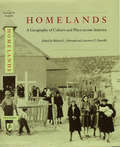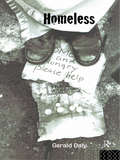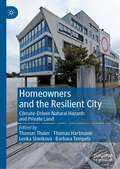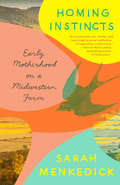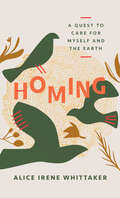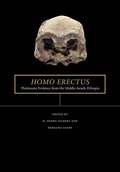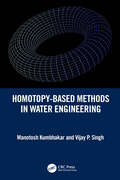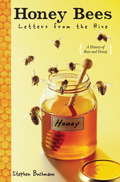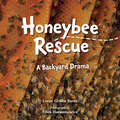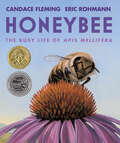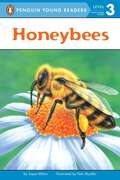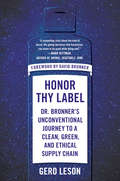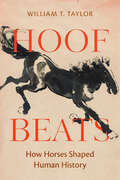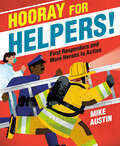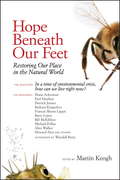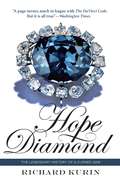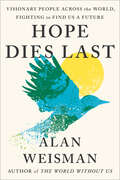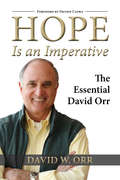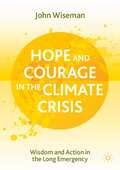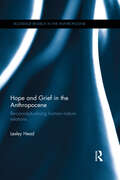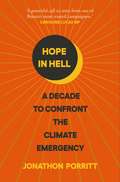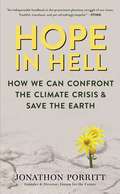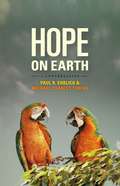- Table View
- List View
Homelands: A Geography of Culture and Place across America (Creating the North American Landscape)
by Richard L. Nostrand Lawrence E. EstavilleWhat does it mean to be from somewhere? If most people in the United States are "from some place else" what is an American homeland? In answering these questions, the contributors to Homelands: A Geography of Culture and Place across America offer a geographical vision of territory and the formation of discrete communities in the U.S. today. Homelands discusses groups such as the Yankees in New England, Old Order Amish in Ohio, African Americans in the plantation South, Navajos in the Southwest, Russians in California, and several other peoples and places. Homelands explores the connection of people and place by showing how aspects of several different North American groups found their niche and created a homeland. A collection of fifteen essays, Homelands is an innovative look at geographical concepts in community settings. It is also an exploration of the academic work taking place about homelands and their people, of how factors such as culture, settlement, and cartographic concepts come together in American sociology. There is much not only to study but also to celebrate about American homelands. As the editors state, "Underlying today's pluralistic society are homelands—large and small, strong and weak—that endure in some way. The mosaic of homelands to which people bonded in greater or lesser degrees, affirms in a holistic way America's diversity, its pluralistic society." The authors depict the cultural effects of immigrant settlement. The conviction that people need to participate in the life of the homeland to achieve their own self realization, within the traditions and comforts of that community. Homelands gives us a new map of the United States, a map drawn with people's lives and the land that is their home.
Homeless: Policies, strategies and Lives on the Streets
by Gerald DalyThe causes of homelessness are disputed by both Right and Left. But, few would argue that life on the streets is anything other than dangerous and debilitating. Unemployment, deinstitutionalisation, abuse in the home are among the stories the homeless tell. Voluntary organisations point to the failure of emergency shelters and food banks, the cut-backs in social programmes and the severe shortage of affordable housing. On the international scale, the changing global system has placed new demands on the economies of Europe and north America which have impacted on resources, employment and even political will. This book is the first comprehensive international study of homelessness. The author argues that the category of the homeless must itself be broadened, to encompass those chronically without shelter to those in immediate risk of dispossession, if homelessness is to be tackled effectively (before and after it happens) by public policy, voluntary organisations and the individuals themselves.
Homeowners and the Resilient City: Climate-Driven Natural Hazards and Private Land
by Thomas Thaler Thomas Hartmann Lenka Slavíková Barbara TempelsThis book provides an important overview of how climate-driven natural hazards like river or pluvial floods, droughts, heat waves or forest fires, continue to play a central role across the globe in the 21st century. Urban resilience has become an important term in response to climate change. Resilience describes the ability of a system to absorb shocks and depends on the vulnerability and recovery time of a system. A shock affects a system to the extent that it becomes vulnerable to the event. This book focus examines how private property-owners might implement such measures or improve their individual coping and adaptive capacity to respond to future events. The book looks at the existence of various planning, legal, financial incentives and psychological factors designed to encourage individuals to take an active role in natural hazard risk management and through the presentation of theoretical discussions and empirical cases shows how urban resilience can be achieved. In addition, the book guides the reader through different conceptual frameworks by showing how urban regions are trying to reach urban resilience on privately-owned land. Each chapter focuses on different cultural, socio-economic and political backgrounds to demonstrate how different institutional frameworks have an impact.
Homing Instincts: Early Motherhood on a Midwestern Farm
by Sarah MenkedickSarah Menkedick spent her twenties trekking alone across South America, teaching English to recalcitrant teenagers on Reunion Island, picking grapes in France and camping on the Mongolian grasslands; for her, meaning and purpose were to be found on the road, in flight from the ordinary. Yet the biggest and most transformative adventure of her life might be one she never anticipated: at 31, she moves into a tiny 19th-century cabin on her family's Ohio farm, and begins the journey into motherhood. In eight vivid and boldly questioning essays, Menkedick explores the luminous, disorienting time just before and after becoming a mother. As she reacquaints herself with the subtle landscapes of the Midwest, and adjusts to the often surprising physicality of pregnancy, she ruminates on what this new stage of life means for her long-held concepts of self, settling, and creative fulfillment. In “Millie, Mildred, Grandma Menkedick,” she considers the nature of story through the life of her tough German grandmother, who raised two boys as a single mother in the 1950s and then spent her seventies traveling the world with her best friend Marge; in “Motherland,” on a trip back to Oaxaca, Mexico to visit her husband’s family, she finally embraces her Midwestern roots; in “The Milk Cave,” she discovers in breastfeeding a new appreciation for the spiritual and artistic potential of boredom; and in “The Lake,” she revisits her childhood with her father, whose relentless optimism and mystical streak she sees anew once she has a child of her own. A story of a traveler come home to the farm; of becoming a mother in spite of reservations and doubt; and of learning to appreciate the power and beauty of the quotidian, Homing Instincts speaks to the deepest concerns and hopes of a generation.
Homing: A Quest to Care for Myself and the Earth
by Alice Irene WhittakerA memoir about abandoning an exhausting commuter lifestyle to move to a cabin in the woods, embracing imperfection while cultivating a life of care for self and nature.Alice Irene Whittaker was addicted to productivity, perfectionism, and discipline, making sure that every single moment of the day was accounted for. Then she finds herself as a new mother, commuting four hours a day into the city, exhausted by the state of the world, paralyzed by climate guilt and anxiety. Overnight, Alice Irene and her family decide to retreat to a cabin in the woods, in search of a new kind of life. Surrounded by creek, meadow, and forest, Alice Irene begins a new lifelong journey of repairing her fractured relationship with both herself and the natural world. Her quest takes her to meet a renowned economist-rancher in Colorado, to stand at the side of a runway at a sustainable fashion show in Portland, and to witness firsthand rewilding of wolves in Yellowstone. She interviews and learns from dozens of people who are building homes, growing food, making clothes, raising families, and living their lives in regenerative ways. Searching for the spaces between the sorrow of wildfires and the beauty of wildflowers, Homing is a lyrical memoir about moving from a life of despair to a life of care.
Homo Erectus: Pleistocene Evidence from the Middle Awash, Ethiopia
by W. Henry Gilbert Berhane AsfawThis book provides the first detailed descriptions, photographs, and analysis of the fossil vertebrates--from elephants and hyenas to humans--from the Daka Member of the Bouri Formation of the Afar, a place renowned for an abundant and lengthy record of human ancestors.
Homogeneous Turbulence Dynamics
by Pierre Sagaut Claude CambonThis book provides state-of-the-art results and theories in homogeneous turbulence, including anisotropy and compressibility effects with extension to quantum turbulence, magneto-hydodynamic turbulence and turbulence in non-newtonian fluids. Each chapter is devoted to a given type of interaction (strain, rotation, shear, etc.), and presents and compares experimental data, numerical results, analysis of the Reynolds stress budget equations and advanced multipoint spectral theories. The role of both linear and non-linear mechanisms is emphasized. The link between the statistical properties and the dynamics of coherent structures is also addressed. Despite its restriction to homogeneous turbulence, the book is of interest to all people working in turbulence, since the basic physical mechanisms which are present in all turbulent flows are explained. The reader will find a unified presentation of the results and a clear presentation of existing controversies. Special attention is given to bridge the results obtained in different research communities. Mathematical tools and advanced physical models are detailed in dedicated chapters.
Homogenization Algebras and Applications: A Deterministic Homogenization Theory (Springer Monographs in Mathematics)
by Gabriel NguetsengThe book presents a deterministic homogenization theory intended for the mathematical analysis of non-stochastic multiscale problems, both within and beyond the periodic setting. The main tools are the so-called homogenization algebras, the classical Gelfand representation theory, and a class of actions by the multiplicative group of positive real numbers on numerical spaces. The basic approach is the Sigma-convergence method, which generalizes the well-known two-scale convergence procedure. Numerous problems are worked out to illustrate the theory and highlight its broad applicability. The book is primarily intended for researchers (including PhD students) and lecturers interested in periodic as well as non-periodic homogenization theory.
Homotopy-Based Methods in Water Engineering
by Vijay P. Singh Manotosh KumbhakarMost complex physical phenomena can be described by nonlinear equations, specifically, differential equations. In water engineering, nonlinear differential equations play a vital role in modeling physical processes. Analytical solutions to strong nonlinear problems are not easily tractable, and existing techniques are problem-specific and applicable for specific types of equations. Exploring the concept of homotopy from topology, different kinds of homotopy-based methods have been proposed for analytically solving nonlinear differential equations, given by approximate series solutions. Homotopy-Based Methods in Water Engineering attempts to present the wide applicability of these methods to water engineering problems. It solves all kinds of nonlinear equations, namely algebraic/transcendental equations, ordinary differential equations (ODEs), systems of ODEs, partial differential equations (PDEs), systems of PDEs, and integro-differential equations using the homotopy-based methods. The content of the book deals with some selected problems of hydraulics of open-channel flow (with or without sediment transport), groundwater hydrology, surface-water hydrology, general Burger’s equation, and water quality. Features: Provides analytical treatments to some key problems in water engineering Describes the applicability of homotopy-based methods for solving nonlinear equations, particularly differential equations Compares different approaches in dealing with issues of nonlinearity
Honey Bees: Letters from the Hive
by Stephen BuchmannA fascinating look at the story of bees, the many extraordinary and often unexpected ways they've enriched our lives from prehistoric times to today, and their importance in keeping the food chain thriving. This is the perfect book for honey lovers young and old, as well as a great choice for middle and high school book reports or for use as a resource for science projects. Readers will be taken into the hive-one part nursery, one part honey factory, one part queen's inner sanctum-then fly through backyard gardens, open fields, and deserts where wildflowers bloom. It's fascinating and delicious! For honey fanatics and all who have a sweet tooth, this book not only entertains and enlightens but also reminds us of the fragility of humanity's relationship with nature.
Honeybee Rescue: A Backyard Drama
by Loree BurnsFans of the Scientists in the Field series will love discovering ways to save and protect bees through the eyes of a honeybee rescuer. Follow honeybee rescuer Mr. Nelson as he expertly removes a colony of bees from Mr. Connery's barn (with a vacuum!) and helps it relocate back to a hive. Photographs of Mr.Nelson’s relocation of the colony help bring the honeybee rescue to life. <P><P> Nature lovers and scientists-to-be will be abuzz as they learn all the ways to keep honeybees (and our ecosystem) safe. <P><P><i>Advisory: Bookshare has learned that this book offers only partial accessibility. We have kept it in the collection because it is useful for some of our members. Benetech is actively working on projects to improve accessibility issues such as these.</i>
Honeybee: The Busy Life of Apis Mellifera
by Candace FlemingRobert F. Sibert Medal Winner Take to the sky with Apis, one honeybee, as she embarks on her journey through life!An Orbis Pictus Honor BookSelected for the Texas Bluebonnnet Master ListFinalist for the AAAS/Subaru SB&F Prize for Excellence in Science Books A tiny honeybee emerges through the wax cap of her cell. Driven to protect and take care of her hive, she cleans the nursery and feeds the larvae and the queen. But is she strong enough to fly? Not yet! Apis builds wax comb to store honey, and transfers pollen from other bees into the storage. She defends the hive from invaders. And finally, she begins her new life as an adventurer. The confining walls of the hive fall away as Apis takes to the air, finally free, in a brilliant double-gatefold illustration where the clear blue sky is full of promise-- and the wings of dozens of honeybees, heading out in search of nectar to bring back to the hive. Eric Rohmann's exquisitely detailed illustrations bring the great outdoors into your hands in this poetically written tribute to the hardworking honeybee. Award-winning author Candace Fleming describes the life cycle of the honeybee in accessible, beautiful language. Similar in form and concept to the Sibert and Orbis Pictus award book Giant Squid, Honeybee also features a stunning gatefold and an essay on the plight of honeybees.Cook Prize Honor BookA Kids' Book Choice Award FinalistAn American Library Association Notable Children&’s BookA New York Public Library Best Book of the YearNamed a Best Book of the Year by Kirkus Reviews, NPR, Shelf Awareness, School Library Journal, Publishers Weekly and more!A Horn Book Fanfare Best Book of the YearA Bank Street Best Children's Book of the Year!A Bulletin of the Center for Children's Books Blue Ribbon BookA Booklist Editor's ChoiceNamed to the Texas Topaz Reading ListA Junior Library Guild Gold Standard Selection
Honeybees (Penguin Young Readers, Level 3)
by Joyce MiltonBzzz! Learn all about the life cycle of honeybees, how they make honey, and more. With fun bee facts and bright, realistic artwork, this Station Stop 2 easy reader will fly off bookshelves!Illustrated by Pete Mueller.
Honor Thy Label: Dr. Bronner's Unconventional Journey to a Clean, Green, and Ethical Supply Chain
by Gero Leson&“A compelling story about the kind of moral, life-giving decisions that businesses can make to do good while doing well.&”—Mark Bittman, author of Animal, Vegetable, JunkWhat's in a label? For Dr. Bronner's, more than ingredients or intentions—it spells out an ethical commitment to fairness and sustainable growth, uniting consumers and companies worldwide. Dr. Bronner&’s Magic Soaps are renowned for their dense product labels (&“All-One!&”) and the curious tingling of peppermint. But how did this unusual natural soap transform the small print into soaring sales—inspiring customer loyalty not just with lather, but with good clean business? In Honor Thy Label, Dr. Bronner&’s head of Special Operations, Gero Leson, reveals the inside story of how a little-known family-run soap company grew from countercultural roots to create a revolutionary fair trade and organic supply chain from the ground up—and rode the waves of popular demand without losing sight of the process. Through stories of harrowing setbacks and hard-won triumphs in projects that spanned the globe, in Sri Lanka, Ghana, India, and beyond, Leson demystifies the process of building and scaling ethical production. And he proves that if done right, the results ripple outward to benefit customers, communities, and the environment we share. Told with spirit and conviction, Honor Thy Label invites socially conscious entrepreneurs and shoppers on a journey to break the boundaries of production with the pioneers of socially just business—spreading Dr. Bronner&’s radical vision of simple ingredients with cosmic impact.
Hoof Beats: How Horses Shaped Human History
by William T. TaylorJourney to the ancient past with cutting-edge science and new data to discover how horses forever altered the course of human history. From the Rockies to the Himalayas, the bond between horses and humans has spanned across time and civilizations. In this archaeological journey, William T. Taylor explores how momentous events in the story of humans and horses helped create the world we live in today. Tracing the horse's origins and spread from the western Eurasian steppes to the invention of horse-drawn transportation and the explosive shift to mounted riding, Taylor offers a revolutionary new account of how horses altered the course of human history. Drawing on Indigenous perspectives, ancient DNA, and new research from Mongolia to the Great Plains and beyond, Taylor guides readers through the major discoveries that have placed the horse at the origins of globalization, trade, biological exchange, and social inequality. Hoof Beats transforms our understanding of both horses and humanity's ancient past and asks us to consider what our relationship with horses means for the future of humanity and the world around us.
Hooray for Helpers!: First Responders and More Heroes in Action
by Mike AustinCelebrate first responders in this timely, action-packed picture book featuring firefighters, doctors, EMTs, and other brave helpers in action!First responders are on the way! Every day, brave helpers are on full alert, ready to rescue people and animal friends in need. They work on land, go underground, and even parachute down from the sky. Buckle up and cheer for these heroes as they go the distance to keep everyone safe.With bright, colorful art and labels of rescue vehicles and equipment in the style of Richard Scarry, this introduction to and celebration of first responders packs FUN and FACTS. Look inside for a Q&A with a real firefighter and an emergency supplies list!Ready for more action? Check out Fire Engine No. 9 and Rescue Squad No. 9!
Hope Beneath Our Feet: Restoring Our Place in the Natural World
by Barbara Kingsolver Alice Walker Howard Zinn Michael Pollan Martin KeoghThe environmental "tipping point" we approach is more palpable each day, and people are seeing it in ways they can no longer ignore--we need only turn on the news to hear the litany of what is wrong around us. Serious reflection, inspiration, and direction on how to approach the future are now critical. Hope Beneath Our Feet creates a space for change with stories, meditations, and essays that address the question, "If our world is facing an imminent environmental catastrophe, how do I live my life right now?" This collection provides tools, both practical and spiritual, to those who care about our world and to those who are just now realizing they need to care. Featuring prominent environmentalists, artists, CEOs, grassroots activists, religious figures, scientists, policy makers, and indigenous leaders, Hope Beneath Our Feet shows readers how to find constructive ways to channel their energies and fight despair with engagement and participation. Presenting diverse strategies for change as well as grounds for hope, the contributors to this anthology celebrate the ways in which we can all engage in beneficial action for ourselves, our communities, and the world.Contributors include: Diane Ackerman, Paul Hawken, Derrick Jensen, Barbara Kingsolver, Francis Moore Lappé, Barry Lopez, Bill McKibben, Michael Pollan, Alice Walker, Howard Zinn.
Hope Diamond: The Legendary History of a Cursed Gem
by Richard Kurin David J. SkortonThe true story behind the most famous-and infamous-stone in the world. The Hope diamond is not only exceptionally beautiful it has a long and incredibly colorful history. That history - spread over three continents - features diamond mining in India, the French Revolution, the machinations of British King George IV, the Gilded Age in America and a number of very clever jewelers including Pierre Cartier and Harry Winston. In the 20th century, the myth of the Hope diamond curse made the diamond more notorious and famous than ever before, but it is only one small piece of a long and lustrous history. Dr. Kurin, who is a cultural anthropologist, has spent over a decade on the trail of the Hope, from India, to France, Germany, Russia, Switzerland, and England. His narrative is filled with fascinating places and people - from the fabled diamond city of Golconda to the fabulously rich heiress Evalyn McLean to Jackie Kennedy and her pivotal role in one of the Hopes few 20th century trips abroad.
Hope Dies Last: Visionary People Across the World, Fighting to Find Us a Future
by Alan WeismanOne of Heatmap's 18 Climate Books to Read in 2025The award-winning environmental journalist&’s extraordinary, long-awaited portrait of hope and resilience as we face a fractured and uncertain futureIn this profoundly human and moving narrative, the bestselling author of The World Without Us returns with a book ten years in the making: a study of what it means to be a human on the front lines of our planet&’s existential crisis. His new book, Hope Dies Last, is a literary evocation of our current predicament and the core resolve of our species against the most precarious odds we have ever faced.To write this book, Weisman traveled the globe, witnessing climate upheaval and other devastations, and meeting the people striving to mitigate and undo our past transgressions. From the flooding Marshall Islands to revived wetlands in Iraq, from the Netherlands and Bangladesh to the Korean DMZ and to cities and coastlines in the U.S. and around the world, he has encountered the best of humanity battling heat, hunger, rising tides, and imperiled nature. He profiles the innovations of big thinkers—engineers, scientists, conservationists, economists, architects, and artists—as they conjure wildly creative, imaginative responses to an uncertain, ominous future. At this unprecedented point in history, as our collective exploits on this planet may lead to our own undoing and we could be among the species marching toward extinction, they refuse to accept defeat.Hope Dies Last fills a crucial gap in the global conversation: Having reached a point of no return in our climate confrontation, how do we feel, behave, act, plan, and dream as we approach a future decidedly different from what we had expected?
Hope Is an Imperative: The Essential David Orr
by Fritjof Capra David W. OrrFor more than three decades, David Orr has been one of the leading voices of the environmental movement, championing the cause of ecological literacy in higher education, helping to establish and shape the field of ecological design, and working tirelessly to raise awareness of the threats to future generations posed by humanity's current unsustainable trajectory. Hope Is an Imperative brings together in a single volume Professor Orr's most important works. These include classics such as "What Is Education For?," one of the most widely reprinted essays in the environmental literature, "The Campus and the Biosphere," which helped launch the green campus movement,and "Loving Children: A Design Problem," which renowned theologian and philosopher Thomas Berry called "the most remarkable essay I've read in my whole life." The book features thirty-three essays, along with an introductory section that considers the evolution of environmentalism, section introductions that place the essays into a larger context, and a foreword by physicist and author Fritjof Capra. Hope Is an Imperative is a comprehensive collection of works by one of the most important thinkers and writers of our time. It offers a complete introduction to the writings of David Orr for readers new to the field, and represents a welcome compendium of key essays for longtime fans. The book is a must-have volume for every environmentalist's bookshelf.
Hope and Courage in the Climate Crisis: Wisdom and Action in the Long Emergency
by John WisemanAs the risks of the climate crisis continue to grow, so too do the challenges of facing a harsh climate future with honesty and courage; justice and compassion; meaning and purpose. Hope and Courage in the Climate Crisis explores diverse sources of learning and wisdom –from climate scientists and activists; philosophers and social theorists; Indigenous cultures and ways of life; faith based and spiritual traditions; artists and writers –which can help us live courageous, compassionate and creative lives in a world of rapidly accelerating climatic and ecological risk.Accelerating the transition to a just and resilient zero-carbon society will require visionary leadership and courageous collective action. Awareness that rapid action might still be insufficient to prevent severe and irreversible social and ecological damage is however a source of deep concern for many people passionately committed to decisive climate action. Drawing on broad experience as a climate activist, researcher and policy maker John Wiseman provides a wide ranging, accessible and provocative guided tour of ideas which can inspire and sustain radical hope and defiant courage in the long emergency which now lies before us.
Hope and Grief in the Anthropocene: Re-conceptualising human–nature relations (Routledge Research in the Anthropocene)
by Lesley HeadThe Anthropocene is a volatile and potentially catastrophic age demanding new ways of thinking about relations between humans and the nonhuman world. This book explores how responses to environmental challenges are hampered by a grief for a pristine and certain past, rather than considering the scale of the necessary socioeconomic change for a 'future' world. Conceptualisations of human-nature relations must recognise both human power and its embeddedness within material relations. Hope is a risky and complex process of possibility that carries painful emotions; it is something to be practised rather than felt. As centralised governmental solutions regarding climate change appear insufficient, intellectual and practical resources can be derived from everyday understandings and practices. Empirical examples from rural and urban contexts and with diverse research participants - indigenous communities, climate scientists, weed managers, suburban householders - help us to consider capacity, vulnerability and hope in new ways.
Hope in Hell: A decade to confront the climate emergency
by Jonathon Porritt&‘Brave and unflinching in setting out the reality of the hell towards which we&’re headed, but even more urgent, passionate and compelling about the grounds for hope if we change course fast enough, Hope in Hell is a powerful call to arms from one of Britain&’s most eloquent and trusted campaigners.&’ Caroline Lucas, MP'Extraordinarily powerful, deeply troubling, scathing but ultimately purposeful and hopeful. This book is a clarion call to action, and action now. After reading this, we know for sure that nothing, not even a pandemic, must divert us from the most serious problem facing every living creature on the planet. In plain language, Jonathon Porritt is spelling it out. This is our last chance. Read, mark, learn, and inwardly digest. Then act.' Michael Morpurgo Climate change is the defining issue of our time - we know, beyond reasonable doubt, what that science now tells us. Just as climate change is accelerating, so too must we – summoning up a greater sense of urgency, courage and shared endeavour than humankind has ever seen before. The Age of Climate Change is an age of superlatives: most extreme this, biggest that, most costly ever. The impacts worsen every year, played out in people&’s backyards and communities, and more and more people around the world now realise this is going to be a massive challenge for the rest of their lives. In Hope in Hell, Porritt confronts that dilemma head on. He believes we have time to do what needs to be done, but only if we move now – and move together. In this ultimately optimistic book, he explores all these reasons to be hopeful: new technology; the power of innovation; the mobilisation of young people – and a sense of intergenerational solidarity as older generations come to understand their own obligation to secure a safer world for their children and grandchildren.
Hope in Hell: How We Can Confront the Climate Crisis & Save the Earth
by Jonathon PorrittA book for facing head-on—and averting—the oncoming global climate change disaster, by inspiring people to move from general concern and passive support to active protagonists for change.Climate change is our era's defining issue. We know, beyond reasonable doubt, that climate change is accelerating. To face a challenge greater than humanity has ever seen before, we must also accelerate ourselves, by summoning a sense of urgency, courage, and shared effort to match it. Jonathan Porritt's Hope In Hell is meant to do just that, by confronting the issue directly and strongly, but also with inspiration and hope; it's not too late to avoid the worst consequences of climate change. Ultimately optimistic despite the dire challenge presented to the world, Porritt explores current science and new technologies, mobilization of younger people and political action, and encouraging intergenerational solidarity as older generations learn their own responsibilities in creating a better world for their successors.
Hope on Earth: A Conversation
by Paul R. Ehrlich Michael Charles TobiasHope on Earth is the thought-provoking result of a lively and wide-ranging conversation between two of the world’s leading interdisciplinary environmental scientists: Paul R. Ehrlich, whose book The Population Bomb shook the world in 1968 (and continues to shake it), and Michael Charles Tobias, whose over 40 books and 150 films have been read and/or viewed throughout the world. Hope on Earth offers a rare opportunity to listen in as these deeply knowledgeable and highly creative thinkers offer their takes on the most pressing environmental concerns of the moment. Both Ehrlich and Tobias argue that we are on the verge of environmental catastrophe, as the human population continues to grow without restraint and without significant attempts to deal with overconsumption and the vast depletion of resources and climate problems it creates. Though their views are sympathetic, they differ in their approach and in some key moral stances, giving rise to a heated and engaging dialogue that opens up dozens of new avenues of exploration. They both believe that the impact of a human society on its environment is the direct result of its population size, and through their dialogue they break down the complex social problems that are wrapped up in this idea and attempts to overcome it, hitting firmly upon many controversial topics such as circumcision, religion, reproduction, abortion, animal rights, diet, and gun control. For Ehrlich and Tobias, ethics involve not only how we treat other people directly, but how we treat them and other organisms indirectly through our effects on the environment. University of California, Berkeley professor John Harte joins the duo for part of the conversation, and his substantial expertise on energy and climate change adds a crucial perspective to the discussion of the impact of population on global warming. This engaging and timely book invites readers into an intimate conversation with some of the most eminent voices in science as they offer a powerful and approachable argument that the ethical and scientific issues involved in solving our environmental crisis are deeply intertwined, while offering us an optimistic way forward. Hope on Earth is indeed a conversation we should all be having.
